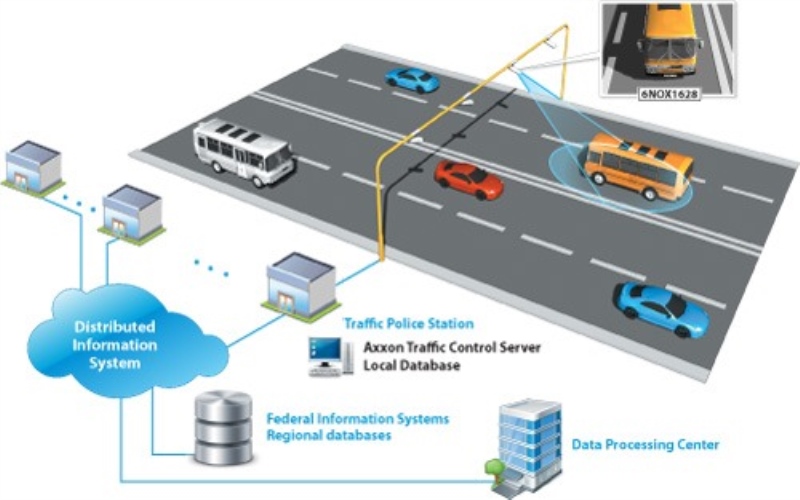Cities all over the world face the issue of traffic congestion and the challenges that come with it. Therefore, an efficient traffic management system is needed. One solution that is widely recognized as a reliable solution is Automatic License Plate Recognition software (ALPR).
ALPR systems use cameras and optical character recognition (OCR) technology to read and capture license plate numbers. The information is converted into digital data, making it easier to manage and analyze the collected data in real-time. Let’s take a closer look at how ALPR software works and explore its potential benefits for traffic management.
Why Use ALPR API Integration for Traffic Management
ALPR has significantly improved traffic flow and management in various big cities. It is now easier to automatically identify, track, and analyze vehicles on the road, all thanks to the integration of automatic license plate recognition software. Here’s why it’s beneficial for traffic management:
Real-time Traffic Monitoring
ALPR makes it possible to collect and analyze traffic data in real-time with utmost precision and efficiency. This system is designed to handle and process a massive amount of information seamlessly. As a result, it provides traffic management authorities with accurate, up-to-date data.
By leveraging the power of ALPR, traffic monitoring can be optimized to enhance road safety, improve traffic flow, and ultimately create a smoother and more efficient transportation network.
Automated Traffic Offence Detection
Automatic license plate recognition software transforms law enforcement by creating a comprehensive digital database. There, it’s easy to store license plate numbers securely. This database is a powerful tool ideal for monitoring and tracking on-road activities to address traffic violations as swiftly as possible.
The ALPR software not only identifies license plate numbers but also analyzes the data to flag various traffic violations. By leveraging this technology, law enforcement agencies can efficiently enforce traffic laws and create a safe environment.
Better Traffic Flow
By capturing and processing license plate information, ALPR enables the analysis of traffic patterns with remarkable precision.
The insights derived from ALPR data empower transportation authorities to make informed decisions. They can implement necessary adjustments to optimize traffic flow. For instance, the software can intelligently suggest strategically redirecting vehicles to less congested areas, resulting in an efficient transportation system.
With its ability to provide detailed and accurate traffic information, ALPR software can change how traffic management is approached.
Improved Public Safety
Aside from efficiently managing traffic, automatic license plate recognition software plays a crucial role in crime prevention and detection. This powerful technology enables seamless information sharing with law enforcement agencies.
It facilitates the identification of stolen vehicles, tracks suspicious criminal activities, and enhances public safety. The advanced capabilities of ALPR make it an invaluable tool in ensuring a secure and protected community for all.
Challenges of Relying on ALRP API Services
While ALPR software has proven beneficial in traffic management, it also poses some challenges that authorities need to address:
Accuracy Issues
Just like any other technology, ALPR systems are not 100% accurate. Several factors can influence their accuracy, including poor lighting conditions, unclear or damaged license plates, and the camera’s angle capturing the images.
These variables can affect the system’s ability to correctly identify and collect data from license plates, potentially leading to incorrect traffic management decisions. It is crucial to consider these limitations when relying on ALPR systems for accurate and reliable information.
Possibility of Hacking
As with any technology that relies on the internet, ALPR software is susceptible to hacking. If unauthorized individuals gain access to the system, they could potentially manipulate traffic data, leading to inaccurate records and compromising public safety.
Moreover, the misuse of ALPR data for criminal activities poses a significant concern. Therefore, it is essential to acknowledge these risks and implement robust measures to ensure the utmost security and integrity of the system.
Dependency on Technology
Relying solely on automatic license plate recognition software for traffic management can lead to a potential dependency on technology, which may result in the neglect of human intervention.
However, authorities must recognize the importance of striking a balance between technology and human involvement. In the event of system failure or technical issues, having well-defined contingency plans in place becomes imperative to manage traffic flow effectively.
Regular maintenance and backups should also be prioritized to ensure the smooth functioning and reliability of the system in the long run. By considering these factors, traffic management can achieve a harmonious integration of technology and human expertise.
Maintenance Issues
ALPR plays a crucial role in efficient data collection. However, to ensure their optimal performance, regular maintenance is required. Dust, debris, and even harsh weather conditions can adversely affect the camera lenses, potentially leading to errors or inaccurate data.
Therefore, it is essential to establish a well-defined schedule for cleaning and maintaining the system. By doing so, you can maximize the longevity and reliability of ALPR software, ensuring consistent and accurate results.
Conclusion
With its real-time monitoring capabilities and automated features, automatic license plate recognition software has significantly improved traffic flow and public safety. However, some challenges need to be addressed for effective utilization and proper functioning of the system.
By addressing these challenges, cities can continue to take advantage of ALPR software and create a more efficient traffic management system. Therefore, it’s safe to say that ALPR software will continue to be essential for managing traffic in the future.

